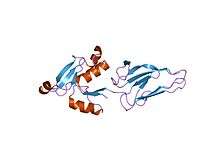Intimin
| Intimin C-type lectin domain | |||||||||
|---|---|---|---|---|---|---|---|---|---|
 nmr representative structure of intimin-190 (int190) from enteropathogenic e. coli | |||||||||
| Identifiers | |||||||||
| Symbol | Intimin_C | ||||||||
| Pfam | PF07979 | ||||||||
| Pfam clan | CL0056 | ||||||||
| InterPro | IPR013117 | ||||||||
| |||||||||
Intimin is a virulence factor (adhesin) of EPEC (e.g. E. coli O127:H6) and EHEC (e.g. E. coli O157:H7) E. coli strains. It is an attaching and effacing (A/E) protein which with other virulence factors is responsible for enteropathogenic and enterohaemorrhagic diarrhoea.[1]
Intimin is expressed on the bacterial cell surface where it can bind to its receptor Tir (Translocated intimin receptor). Tir, along with over 25 other bacterial proteins, is secreted from attaching and effacing E. coli directly into the cytoplasm of intestinal epithelial cells by a Type three secretion system. Once within the cytoplasm of the host cell, Tir is inserted into the plasma membrane, allowing surface exposure and intimin binding.[1]
The structure of the C-terminal domain has been solved and shown to have a C-lectin type of structure.[2]
It is a 94 kDa outer membrane protein encoded by eaeA gene in the locus of enterocyte effacement. Mutations in the eaeA gene result in loss of ability to cause A/E lesions, and is required for full virulence in infected volunteers and animal models. The N-terminal domains of intimin from A/E lesion forming pathogens have high homology with each other and to invasin from Yersinia pseudotuberculosis and Yersinia enterocolitica, whereas the C-terminal domains show less homology.
Antibodies to intimin are present in: (1) Immune colostrum from mothers in EPEC endemic areas, (2) The serum of EPEC/EHEC infected children and EPEC infected volunteers, and (3) Secretions of Citrobacter rodentium infected mice.
References
- 1 2 Stevens, J.; et al. (2006). "Actin-dependent movement of bacterial pathogens". Nature Reviews Microbiology. 4: 91–101. doi:10.1038/nrmicro1320. PMID 16415925.
- ↑ Batchelor M, Prasannan S, Daniell S, Reece S, Connerton I, Bloomberg G, Dougan G, Frankel G, Matthews S (June 2000). "Structural basis for recognition of the translocated intimin receptor (Tir) by intimin from enteropathogenic Escherichia coli". EMBO J. 19 (11): 2452–64. doi:10.1093/emboj/19.11.2452. PMC 212744
 . PMID 10835344.
. PMID 10835344.
[1] This article incorporates text from the public domain Pfam and InterPro IPR013117
- ↑ Ahmed, S; et al. (2013). "A directed intimin insertion mutant of a rabbit enteropathogenic Escherichia coli (REPEC) is attenuated, immunogenic and elicits serogroup specific protection.". Vet Immunol Immunopathol. 152 (1-2): 146–155. doi:10.1016/j.vetimm.2012.09.035. PMID 23084628.